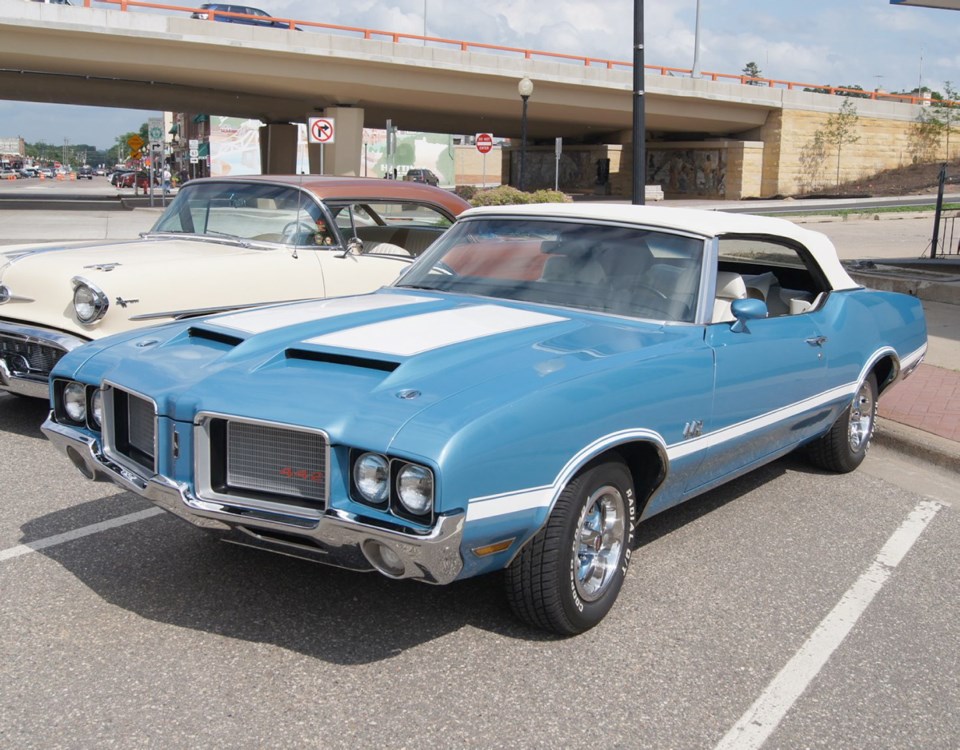The muscle car era began in 1964, when Pontiac installed a 6.4-litre (389 cu. in.) Pontiac V-8 in its lightweight, intermediate-size Tempest and offered it as the GTO option. It tapped into a youth market craving high performance at a reasonable price.
Pontiac sold 32,459 GTOs in its first year, 75,352 in the second and almost 97,000 in the third. It started a new trend of big V-8s in intermediate sedans, a genre soon dubbed the muscle car.
Other brands soon arrived to challenge the GTO, cars such as the Chevrolet Chevelle SS-396, Ford Fairlane GT, Mercury Cyclone GT and Plymouth Road Runner. It started a high-performance era lasting into the early 1970s, when emission controls and soaring insurance rates ended it almost as quickly as it appeared.
Oldsmobile wanted a muscle car, too. It had established an outstanding performance image beginning in 1949 with its all-conquering “Rocket” 88. It became the scourge of the Automobile Association of America and NASCAR circuits in the 1950s, and won the sedan class in the first 1950 Mexican Road Race. But as the decade unfolded, Oldsmobile gradually lost its performance superiority.
Oldsmobile wanted that image back, and its entry in the muscle-car race was the 4-4-2 package on the intermediate F-85 and Cutlass series in mid-1964. It had a 5.4-litre (330 cu. in.), 310-horsepower V-8, with 4-4-2 referring to its four-barrel carburetor, four-on-the-floor manual transmission and twin exhausts. Oldsmobile built 2,999 during its half-year production run.
With a zero to 100 km/h) time of 7.4 seconds, the 4-4-2 didn’t have quite the performance of the GTO’s 6.6 seconds. To address this for 1965, Oldsmobile increased displacement to 6.6 litres (400 cu. in.) giving 345 horsepower.
Performance sparkled with the bigger V-8, with Car and Driver reporting zero to 100 in 5.5 seconds and to 160 km/h in 15.9. It was tire-burning acceleration.
But the 4-4-2 was more than just straight-line acceleration; Oldsmobile engineers added such items as stiffer springs, larger shock absorbers and a rear anti-roll bar, turning the 4-4-2 into what was reputed to be the best handling of the muscle cars.
For 1968, the 4-4-2 became a full series rather than an option package, and this plus all-new styling for the General Motors intermediates helped Olds sell 33,607 4-4-2s. The 6.6-litre (400 cu. in.) engine continued with various power ratings depending on compression ratio, carburetion and transmission, and whether one ordered the optional under-bumper W-30 air induction system.
GM’s intermediates were growing heavier, which contributed to the slower zero-to-100 km/h time of 7.0 seconds that Car Life reported on a 350-horsepower automatic transmission-equipped 4-4-2. To correct this, Olds gave the 4-4-2 an even larger 7.4-litre (455 cu. in.) engine for 1970, which it claimed was the largest ever offered in a special performance car.
Unfortunately, 1971 saw the beginning of performance degradation as emission hardware started to bite and compression ratios fell. This really affected muscle cars, and it would be the 4-4-2’s last year as a separate series.
For 1972, the 4-4-2 was back to an option package of mostly trim, decal and other appearance items on the Cutlass line, but still including enhanced handling components such as heavier anti-roll bars and larger wheels.
This was the theme of the 4-4-2 for the rest of the 1970s: mostly a trim-and-handling option for the Cutlass. As recession loomed in 1980, the 4-4-2 was discontinued.
It came back in 1985, again as an appearance and handling package, but with its own higher performance 5.0-litre (305 cu. in.) V-8 now rated at 180 horsepower by the more realistic Society of Automotive Engineers “net” rating, rather than the previous “gross” rating.
The 4-4-2 disappeared in 1987 as Oldsmobile followed the industry conversion to front-wheel drive. It returned once again for 1990 as the Cutlass Calais Quad 442 (no hyphens) powered by the new Oldsmobile-developed 2.3-litre, double-overhead cam, four-valves-per-cylinder four-cylinder engine. In H.O. (high output) form, it produced 180 horsepower and the 442 now meant four cylinders, four valves per cylinder and two overhead camshafts.
Compared with the early 4-4-2s, the new one was cleaner, more economical and had almost equal performance, all from less than a third of the displacement of the biggest 4-4-2 V-8. It was an environmentally friendly 1990s performance car.
But to muscle-car fans, it wasn’t the real thing. For them, no high-winding little four could replace that sound of a hibernating bear when a big V-8 opened its secondary barrels. A fast-revving four, no matter how high-tech, could never take the place of a big rumbling eight.



